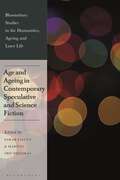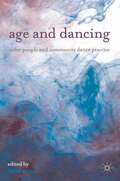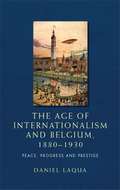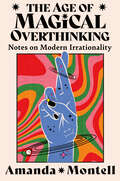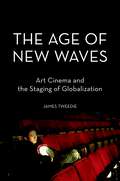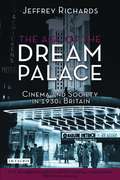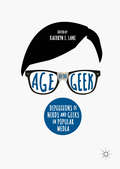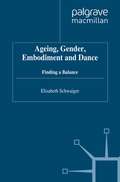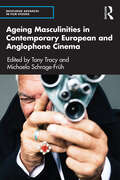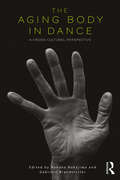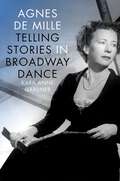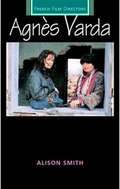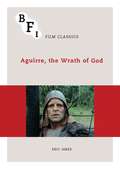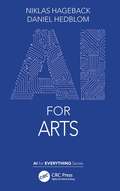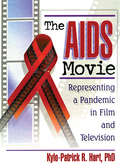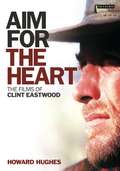- Table View
- List View
Age and Ageing in Contemporary Speculative and Science Fiction (Bloomsbury Studies in the Humanities, Ageing and Later Life)
Focusing on the contemporary period, this book brings together critical age studies and contemporary science fiction to establish the centrality of age and ageing in dystopian, speculative and science-fiction imaginaries. Analysing texts from Europe, North America and South Asia, as well as television programmes and films, the contributions range from essays which establish genre-based trends in the representation of age and ageing, to very focused studies of particular texts and concerns. As a whole, the volume probes the relationship between speculative/science fiction and our understanding of what it is to be a human in time: the time of our own lives and the times of both the past and the future.
Age and Dancing: Older People and Community Dance Practice
by Diane AmansThis highly readable introduction to dance with older people combines key debates and issues in the field with practical guidance, as well as a resources section including numerous 'toolkit materials'. Diane Amans, leading practitioner in Community Dance, provides the ideal beginners' guide for students, practitioners and dance artists alike.
The age of internationalism and Belgium, 1880–1930: Peace, progress and prestige (PDF)
by Daniel LaquaBelgium was a major hub for transnational movements. By taking this small and yet significant European country as a focal point, the book critically examines major issues in modern history, including nationalism, colonial expansion, debates on the nature of international relations and campaigns for political and social equality. Now available in paperback, this study explores an age in which many groups and communities – from socialists to scientists – organised themselves across national borders. The timeframe covers the rise of international movements and associations before the First World War, the conflagration of 1914 and the emergence of new actors such as the League of Nations. The book acknowledges the changing framework for transnational activism, including its interplay with domestic politics and international institutions. By tracing international movements and ideas, the book aims to reveal and explain the multifarious and sometimes contradictory nature of internationalism.
The age of internationalism and Belgium, 1880–1930: Peace, progress and prestige
by Daniel LaquaBelgium was a major hub for transnational movements. By taking this small and yet significant European country as a focal point, the book critically examines major issues in modern history, including nationalism, colonial expansion, debates on the nature of international relations and campaigns for political and social equality. Now available in paperback, this study explores an age in which many groups and communities – from socialists to scientists – organised themselves across national borders. The timeframe covers the rise of international movements and associations before the First World War, the conflagration of 1914 and the emergence of new actors such as the League of Nations. The book acknowledges the changing framework for transnational activism, including its interplay with domestic politics and international institutions. By tracing international movements and ideas, the book aims to reveal and explain the multifarious and sometimes contradictory nature of internationalism.
The Age of Magical Overthinking: Notes On Modern Irrationality
by Amanda MontellIn the modern information age, our brain’s coping mechanisms have been overloaded, and our irrationality turned up to eleven. Amanda Montell blends cultural criticism and personal narrative to explore our modern cognitive biases and the power, disadvantages and highlights of magical overthinking.
The Age of New Waves: Art Cinema and the Staging of Globalization
by James TweedieThe Age of New Waves examines the origins of the concept of the "new wave" in 1950s France and the proliferation of new waves in world cinema over the past three decades. The book suggests that youth, cities, and the construction of a global market have been the catalysts for the cinematic new waves of the past half century. It begins by describing the enthusiastic engagement between French nouvelle vague filmmakers and a globalizing American cinema and culture during the modernization of France after World War II. It then charts the growing and ultimately explosive disenchantment with the aftermath of that massive social, economic, and spatial transformation in the late 1960s. Subsequent chapters focus on films and visual culture from Taiwan and contemporary mainland China during the 1980s and 1990s, and they link the recent propagation of new waves on the international film festival circuit to the "economic miracles" and consumer revolutions accompanying the process of globalization. While it travels from France to East Asia, the book follows the transnational movement of a particular model of cinema organized around mise en scène--or the interaction of bodies, objects, and spaces within the frame--rather than montage or narrative. The "master shot" style of directors like Hou Hsiao-Hsien, Tsai Ming-Liang, and Jia Zhangke has reinvented a crucial but overlooked tendency in new wave film, and this cinema of mise en scène has become a key aesthetic strategy for representing the changing relationships between people and the material world during the rise of a global market. The final chapter considers the interaction between two of the most global phenomena in recent film history--the transnational art cinema and Hollywood--and it searches for traces of an American New Wave.
The Age of New Waves: Art Cinema and the Staging of Globalization
by James TweedieThe Age of New Waves examines the origins of the concept of the "new wave" in 1950s France and the proliferation of new waves in world cinema over the past three decades. The book suggests that youth, cities, and the construction of a global market have been the catalysts for the cinematic new waves of the past half century. It begins by describing the enthusiastic engagement between French nouvelle vague filmmakers and a globalizing American cinema and culture during the modernization of France after World War II. It then charts the growing and ultimately explosive disenchantment with the aftermath of that massive social, economic, and spatial transformation in the late 1960s. Subsequent chapters focus on films and visual culture from Taiwan and contemporary mainland China during the 1980s and 1990s, and they link the recent propagation of new waves on the international film festival circuit to the "economic miracles" and consumer revolutions accompanying the process of globalization. While it travels from France to East Asia, the book follows the transnational movement of a particular model of cinema organized around mise en scène--or the interaction of bodies, objects, and spaces within the frame--rather than montage or narrative. The "master shot" style of directors like Hou Hsiao-Hsien, Tsai Ming-Liang, and Jia Zhangke has reinvented a crucial but overlooked tendency in new wave film, and this cinema of mise en scène has become a key aesthetic strategy for representing the changing relationships between people and the material world during the rise of a global market. The final chapter considers the interaction between two of the most global phenomena in recent film history--the transnational art cinema and Hollywood--and it searches for traces of an American New Wave.
The Age of the Dream Palace: Cinema and Society in 1930s Britain (Cinema and Society)
by Jeffrey RichardsThe period between the two world wars is often named "the golden age of the cinema" in Britain. This definitive and entertaining book on the cinema and cinema-goers of the era is herewith reissued with a new Introduction.Jeffrey Richards, described by Philip French as "a shrewd critic, a compulsive moviegoer, and a professional historian", tells the absorbing story of the cinema during the decade that produced Alfred Hitchcock's thrillers, the musicals of Jessie Matthews and Alexander Korda's epics. He examines the role of going to the pictures in people's lives during a tough period when, in the sumptuous buildings that housed local cinemas, people regularly spent a few pence to purchase ready-made dreams watching Gracie Fields, Robert Donat and the other stars of the day. He scrutinizes the film industry, censorship, cinema's influence, the nature of the star system and its images, as well as the films themselves, including the visions of Britain, British history and society that they created and represented."Jeffrey Richards is admirably equipped to look at the forces shaping the British film industry in the 1930s and to interpret sympathetically a body of films traditionally mocked for their class-bound attitudes… he is full of original insights and illuminating comparisons." - Philip French, 'Observer'"For those with an interest in British Cinema such an enthusiastic and knowledgeable book is a godsend." - Robert Murphy, 'Sight and Sound'
Age of the Geek: Depictions of Nerds and Geeks in Popular Media
by Kathryn E. LaneThis collection examines the nerd and/or geek stereotype in popular culture today. Utilizing the media—film, TV, YouTube, Twitter, fiction—that often defines daily lives, the contributors interrogate what it means to be labeled a “nerd” or “geek.” While the nerd/geek that is so easily recognized now is assuredly a twenty-first century construct, an examination of the terms’ history brings a greater understanding of their evolution. From sports to slasher films, Age of the Geek establishes a dialogue with texts as varied as the depictions of “nerd” or “geek” stereotypes.
Age of the Geek: Depictions of Nerds and Geeks in Popular Media
by Kathryn E. LaneThis collection examines the nerd and/or geek stereotype in popular culture today. Utilizing the media—film, TV, YouTube, Twitter, fiction—that often defines daily lives, the contributors interrogate what it means to be labeled a “nerd” or “geek.” While the nerd/geek that is so easily recognized now is assuredly a twenty-first century construct, an examination of the terms’ history brings a greater understanding of their evolution. From sports to slasher films, Age of the Geek establishes a dialogue with texts as varied as the depictions of “nerd” or “geek” stereotypes.
Ageing, Gender, Embodiment and Dance: Finding a Balance
by E. SchwaigerThis book explores the nexus between gender, ageing and culture in dancers practicing a variety of genres. It challenges existing cultural norms which equate ageing with bodily decline and draws on an interdisciplinary theoretical framework to explore alternatives for developing a culturally valued mature subjectivity through the practice of dance.
Ageing Masculinities in Contemporary European and Anglophone Cinema (Routledge Advances in Film Studies)
by Tony Tracy Michaela Schrage-FrühThis volume offers a unique exploration of how ageing masculinities are constructed and represented in contemporary international cinema. With chapters spanning a range of national cinemas, the primarily European focus of the book is juxtaposed with analysis of the social and cultural constructions of manhood and the "anti-ageing" impulses of male stardom in contemporary Hollywood. These themes are inflected in different ways throughout the volume, from considering how old age is not the monolithic and unified life stage with which it is often framed, to exploring issues of queerness, sexuality, and asexuality, as well as themes such as national cinema and dementia. Offering a diverse and multifaceted portrait of ageing and masculinity in contemporary cinema, this book will be of interest to scholars and students of film and screen studies, gender and masculinity studies, and cultural gerontology.
Ageing Masculinities in Contemporary European and Anglophone Cinema (Routledge Advances in Film Studies)
by Tony Tracy Michaela Schrage-ÜhThis volume offers a unique exploration of how ageing masculinities are constructed and represented in contemporary international cinema. With chapters spanning a range of national cinemas, the primarily European focus of the book is juxtaposed with analysis of the social and cultural constructions of manhood and the "anti-ageing" impulses of male stardom in contemporary Hollywood. These themes are inflected in different ways throughout the volume, from considering how old age is not the monolithic and unified life stage with which it is often framed, to exploring issues of queerness, sexuality, and asexuality, as well as themes such as national cinema and dementia. Offering a diverse and multifaceted portrait of ageing and masculinity in contemporary cinema, this book will be of interest to scholars and students of film and screen studies, gender and masculinity studies, and cultural gerontology.
The Aging Body in Dance: A cross-cultural perspective
by Gabriele Brandstetter Nanako NakajimaWhat does it mean to be able to move? The Aging Body in Dance brings together leading scholars and artists from a range of backgrounds to investigate cultural ideas of movement and beauty, expressiveness and agility. Contributors focus on Euro-American and Japanese attitudes towards aging and performance, including studies of choreographers, dancers and directors from Yvonne Rainer, Martha Graham, Anna Halprin and Roemeo Castellucci to Kazuo Ohno and Kikuo Tomoeda. They draw a fascinating comparison between youth-oriented Western cultures and dance cultures like Japan’s, where aging performers are celebrated as part of the country’s living heritage. The first cross-cultural study of its kind, The Aging Body in Dance offers a vital resource for scholars and practitioners interested in global dance cultures and their differing responses to the world's aging population.
The Aging Body in Dance: A cross-cultural perspective
by Gabriele Brandstetter Nanako NakajimaWhat does it mean to be able to move? The Aging Body in Dance brings together leading scholars and artists from a range of backgrounds to investigate cultural ideas of movement and beauty, expressiveness and agility. Contributors focus on Euro-American and Japanese attitudes towards aging and performance, including studies of choreographers, dancers and directors from Yvonne Rainer, Martha Graham, Anna Halprin and Roemeo Castellucci to Kazuo Ohno and Kikuo Tomoeda. They draw a fascinating comparison between youth-oriented Western cultures and dance cultures like Japan’s, where aging performers are celebrated as part of the country’s living heritage. The first cross-cultural study of its kind, The Aging Body in Dance offers a vital resource for scholars and practitioners interested in global dance cultures and their differing responses to the world's aging population.
Agnes de Mille: Telling Stories in Broadway Dance (Broadway Legacies)
by Kara Anne GardnerThis book explores the Broadway legacy of choreographer Agnes de Mille, from the 1940s through the 1960s. Six musicals are discussed in depth - Oklahoma!, One Touch of Venus, Bloomer Girl, Carousel, Brigadoon, and Allegro. Oklahoma!, Carousel, and Brigadoon were de Mille's most influential and lucrative Broadway works. The other three shows exemplify aspects of her legacy that have not been fully examined, including the impact of her ideas on some of the composers with whom she worked; her ability to incorporate a previously conceived work into the context of a Broadway show; and her trailblazing foray into the role of choreographer/director. Each chapter emphasizes de Mille's unique contributions to the original productions. Several themes emerge in looking closely at de Mille's Broadway repertoire. Character development remained at the heart of her theatrical work work. She often took minor characters, represented with minimal or no dialogue, and fleshed out their stories. These stories added a layer of meaning that resulted in more complex productions. Sometimes, de Mille's stories were different from the stories her collaborators wanted to tell, which caused many conflicts. Because her unique ideas often got woven into the fabric of her musicals, de Mille saw her choreography as an authorship. She felt she should be given the same rights as the librettist and the composer. De Mille's work as an activist is an aspect of her legacy that has largely been overlooked. She contributed to revisions in dance copyright law and was a founding member of the Stage Directors and Choreographers Society, a theatrical union that protects the rights of directors and choreographers. Her contention that choreographers are authors who have their own stories to tell offers a new way of understanding the Broadway musical.
Agnes de Mille: Telling Stories in Broadway Dance (Broadway Legacies)
by Kara Anne GardnerThis book explores the Broadway legacy of choreographer Agnes de Mille, from the 1940s through the 1960s. Six musicals are discussed in depth - Oklahoma!, One Touch of Venus, Bloomer Girl, Carousel, Brigadoon, and Allegro. Oklahoma!, Carousel, and Brigadoon were de Mille's most influential and lucrative Broadway works. The other three shows exemplify aspects of her legacy that have not been fully examined, including the impact of her ideas on some of the composers with whom she worked; her ability to incorporate a previously conceived work into the context of a Broadway show; and her trailblazing foray into the role of choreographer/director. Each chapter emphasizes de Mille's unique contributions to the original productions. Several themes emerge in looking closely at de Mille's Broadway repertoire. Character development remained at the heart of her theatrical work work. She often took minor characters, represented with minimal or no dialogue, and fleshed out their stories. These stories added a layer of meaning that resulted in more complex productions. Sometimes, de Mille's stories were different from the stories her collaborators wanted to tell, which caused many conflicts. Because her unique ideas often got woven into the fabric of her musicals, de Mille saw her choreography as an authorship. She felt she should be given the same rights as the librettist and the composer. De Mille's work as an activist is an aspect of her legacy that has largely been overlooked. She contributed to revisions in dance copyright law and was a founding member of the Stage Directors and Choreographers Society, a theatrical union that protects the rights of directors and choreographers. Her contention that choreographers are authors who have their own stories to tell offers a new way of understanding the Broadway musical.
Agnes Varda (French Film Directors Series)
by Alison SmithThe first introduction in English devoted wholly to Varda and aimed at a general and student audience. Places Varda's major films in the context of her whole oeuvre and follows the development of important themes across her work.
Aguirre, the Wrath of God (BFI Film Classics)
by Eric AmesEric Ames draws on original archival research to provide fresh perspectives on Werner Herzog's breakthrough 1972 film, Aguirre, the Wrath of God (Aguirre, der Zorn Gottes), which portrays an expedition by Spanish conquistadors led by Aguirre (played by Klaus Kinski) to find the legendary city of El Dorado. Ames explores how the film is remembered: for its breathtaking visual style and narrative power, but also for Herzog's tense, behind-the-scenes relationship with star Kinski. Did Herzog really direct him at gunpoint? Did they plot each other's murder? The legends begin here …Ames reconstructs the film as an experiment in visualising the past from the viewpoint of the present. Aguirre is not a history film in the narrow sense, but it does engage a specific episode in the conquest of the New World, and it explores that history in terms of vision. Interweaving close analysis with extensive archival research, Ames explores Aguirre as a seminal film about the madness and hopelessness of Western striving. In addition, as an appendix, he offers for the first time a complete translation of an infamous, secretly recorded argument between Herzog and Kinski on the set.
AI for Arts (AI for Everything)
by Niklas Hageback Daniel HedblomAI for Arts is a book for anyone fascinated by the man–machine connection, an unstoppable evolution that is intertwining us with technology in an ever-greater degree, and where there is an increasing concern that it will be technology that comes out on top. Thus, presented here through perhaps its most esoteric form, namely art, this unfolding conundrum is brought to its apex. What is left of us humans if artificial intelligence also surpasses us when it comes to art? The articulation of an artificial intelligence art manifesto is long overdue, so hopefully this book can fill a gap that will have repercussions not only for aesthetic and philosophical considerations but possibly more so for the development of artificial intelligence.
AI for Arts (AI for Everything)
by Niklas Hageback Daniel HedblomAI for Arts is a book for anyone fascinated by the man–machine connection, an unstoppable evolution that is intertwining us with technology in an ever-greater degree, and where there is an increasing concern that it will be technology that comes out on top. Thus, presented here through perhaps its most esoteric form, namely art, this unfolding conundrum is brought to its apex. What is left of us humans if artificial intelligence also surpasses us when it comes to art? The articulation of an artificial intelligence art manifesto is long overdue, so hopefully this book can fill a gap that will have repercussions not only for aesthetic and philosophical considerations but possibly more so for the development of artificial intelligence.
The AIDS Movie: Representing a Pandemic in Film and Television
by Kylo-Patrick R HartAre people with HIV/AIDS treated fairly in films?Here is a compelling book that provides you with a thorough examination of how HIV/AIDS is characterized and portrayed in film and how this portrayal affects American culture. The AIDS Movie: Representing a Pandemic in Film and Television uncovers the primary ways that films about HIV/AIDS influence American ideology and contribute to society's view of the disease. In The AIDS Movie, professors and scholars in the areas of popular culture, film, sociology, and gay and lesbian studies will discover cross-cultural approaches that can be used to analyze the representation of AIDS in American films made in the first two decades of the pandemic. Giving you insight into the production and circulation of social meanings pertaining to HIV/AIDS, this study explores the social ramifications of such representations for gay men in American society, as well as for the rest of the population. Interesting and informative, The AIDS Movie: Representing a Pandemic in Film and Television examines the ways that AIDS has been represented in American movies over the past two decades, defines and proposes criteria for identifying an “AIDS movie” and explores how these images shape social opinions about AIDS and gay men. The AIDS Movie discusses several character types such as “innocent victims” and “guilty villains” and the process of victim-blaming that occurs in AIDS movies. Defining an “AIDS movie” as a film with at least one character who either has been infected with HIV, has developed AIDS, or is grieving the recent death of a loved one from AIDS, this guide bases standards for these movies on several works, including: Chocolate Babies It's My Party Jeffrey The Living End Grief An Early Frost Men in Love A Place for Annie Philadelphia The Ryan White Story Gia Boys on the SideThe AIDS Movie: Representing a Pandemic in Film and Television is compelling and insightful as it cleverly reveals how AIDS is portrayed in cinema and television, and how that portrayal affects American culture.
The AIDS Movie: Representing a Pandemic in Film and Television
by Kylo-Patrick R HartAre people with HIV/AIDS treated fairly in films?Here is a compelling book that provides you with a thorough examination of how HIV/AIDS is characterized and portrayed in film and how this portrayal affects American culture. The AIDS Movie: Representing a Pandemic in Film and Television uncovers the primary ways that films about HIV/AIDS influence American ideology and contribute to society's view of the disease. In The AIDS Movie, professors and scholars in the areas of popular culture, film, sociology, and gay and lesbian studies will discover cross-cultural approaches that can be used to analyze the representation of AIDS in American films made in the first two decades of the pandemic. Giving you insight into the production and circulation of social meanings pertaining to HIV/AIDS, this study explores the social ramifications of such representations for gay men in American society, as well as for the rest of the population. Interesting and informative, The AIDS Movie: Representing a Pandemic in Film and Television examines the ways that AIDS has been represented in American movies over the past two decades, defines and proposes criteria for identifying an “AIDS movie” and explores how these images shape social opinions about AIDS and gay men. The AIDS Movie discusses several character types such as “innocent victims” and “guilty villains” and the process of victim-blaming that occurs in AIDS movies. Defining an “AIDS movie” as a film with at least one character who either has been infected with HIV, has developed AIDS, or is grieving the recent death of a loved one from AIDS, this guide bases standards for these movies on several works, including: Chocolate Babies It's My Party Jeffrey The Living End Grief An Early Frost Men in Love A Place for Annie Philadelphia The Ryan White Story Gia Boys on the SideThe AIDS Movie: Representing a Pandemic in Film and Television is compelling and insightful as it cleverly reveals how AIDS is portrayed in cinema and television, and how that portrayal affects American culture.
Aim for the Heart: The Films of Clint Eastwood
by Howard HughesClint Eastwood is one of the world's most popular action stars, who has matured into a fine American producer-director. Entertaining, illuminating and packed with information, up to and including "The Changeling", this is the first book to cover his full life in the movies, from his beginnings in 1950s B-movies and in TV's "Rawhide" to "Gran Torino" showing how as both actor and filmmaker Eastwood aims for the heart of the drama, whatever the story. Howard Hughes follows Eastwood's craft through over 50 movies. He looks at his launch into superstardom in Sergio Leone's 1960s spaghetti westerns. Back in America, he built on his success as western hero with such films as "High Plains Drifter" and "The Outlaw Josey Wales", winning an Oscar for "Unforgiven" in 1992. He blasted his way through the seventies and eighties as Inspector Harry Francis Callahan, the last hope for law enforcement in San Francisco. He also monkeyed around in two phenomenally popular films with Clyde the orang-utan, which brought tough-guy Eastwood to a whole new audience and made him the biggest box office star of his generation."Aim for the Heart" also looks at Eastwood's more unusual roles, including "The Beguiled", "The Bridges of Madison County" and "Million Dollar Baby". Since 1970, he has enjoyed parallel success as director-producer of his own Malpaso Productions, with "Bird", "Mystic River" and "Letters from Iwo Jima", demonstrating formidable directing credentials. "Aim for the Heart" covers all Eastwood's movies of many genres in detail, and Eastwood's story is illustrated with film stills, glimpses behind the scenes, and rare poster advertising material. "Aim for the Heart" also includes the most comprehensive credits filmography has ever compiled on Eastwood's work, as star and director.
Aim for the Heart: The Films of Clint Eastwood
by Howard HughesClint Eastwood is one of the world's most popular action stars,who has matured into a fine American producer-director. Entertaining, illuminating and packed with information, up to and including The Changeling, this is the first book to cover his full life in the movies, from his beginnings in 1950s B-movies and in TV's Rawhide to Gran Torino showing how as both actor and filmmaker Eastwood aims for the heart of the drama, whatever the story.Howard Hughes follows Eastwood's craft through over 50 movies. He looks at his launch into superstardom in Sergio Leone's 1960s spaghetti westerns. Back in America, he built on his success as western hero with such films as High Plains Drifter and The Outlaw Josey Wales, winning an Oscar for Unforgiven in 1992. He blasted his way through the seventies and eighties as Inspector Harry Francis Callahan, the last hope for law enforcement in San Francisco. He also monkeyed around in two phenomenally popular films with Clyde the orang-utan, which brought tough-guy Eastwood to a whole new audience and made him the biggest box office star of his generation.Aim for the Heart also looks at Eastwood's more unusual roles, including The Beguiled, The Bridges of Madison County and Million Dollar Baby. Since 1970, he has enjoyed parallel success as directorproducer of his own Malpaso Productions, with Bird, Mystic River and Letters from Iwo Jima, demonstrating formidable directing credentials.Aim for the Heart covers all Eastwood's movies of many genres in detail, and Eastwood's story is illustrated with film stills, glimpses behind the scenes, and rare poster advertising material. Aim for the Heart also includes the most comprehensive credits filmography has ever compiled on Eastwood's work, as star and director.
